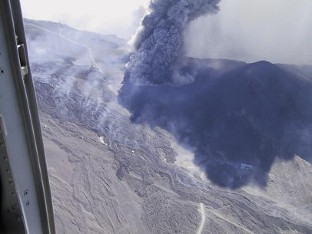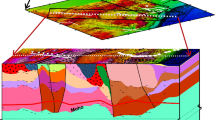Abstract
The July–August 2001 eruption of Mt. Etna stimulated widespread public and media interest, caused significant damage to tourist facilities, and for several days threatened the town of Nicolosi on the S flank of the volcano. Seven eruptive fissures were active, five on the S flank between 3,050 and 2,100 m altitude, and two on the NE flank between 3,080 and 2,600 m elevation. All produced lava flows over various periods during the eruption, the most voluminous of which reached a length of 6.9 km. Mineralogically, the 2001 lavas fall into two distinct groups, indicating that magma was supplied through two different and largely independent pathways, one extending laterally from the central conduit system through radial fissures, the other being a vertically ascending eccentric dike. Furthermore, one of the eccentric vents, at 2,570 m elevation, was the site of vigorous phreatomagmatic activity as the dike cut through a shallow aquifer, during both the initial and closing stages of the eruption. For 6 days the magma column feeding this vent was more or less effectively sealed from the aquifer, permitting powerful explosive and effusive magmatic activity. While the eruption was characterized by a highly dynamic evolution, complex interactions between some of the eruptive fissures, and changing eruptive styles, its total volume (~25×106 m3 of lava and 5–10×106 m3 of pyroclastics) was relatively small in comparison with other recent eruptions of Etna. Effusion rates were calculated on a daily basis and reached peaks of 14–16 m3 s-1, while the average effusion rate at all fissures was about 11 m3 s-1, which is not exceptionally high. The eruption showed a number of peculiar features, but none of these (except the contemporaneous lateral and eccentric activity) represented a significant deviation from Etna's eruptive behavior in the long term. However, the 2001 eruption could be but the first in a series of flank eruptions, some of which might be more voluminous and hazardous. Placed in a long-term context, the eruption confirms a distinct trend, initiated during the past 50 years, toward higher production rates and more frequent eruptions, which might bring Etna back to similar levels of activity as during the early to mid seventeenth century.











Similar content being viewed by others
References
Andronico D, Branca S, Del Carlo P (2001) The 18.7 ka phreatomagmatic flank eruption on Etna (Italy): relationship between eruptive activity and sedimentary basement setting. Terra Nova 13:235–240
Behncke B, Neri M, Carniel R (2003) Endogenous lava dome growth and pyroclastic avalanches during the October–November 1999 Bocca Nuova eruption of Mt. Etna (Italy). J Volcanol Geotherm Res (in press)
Bonaccorso A, Aloisi M, Mattia M (2002) Dike emplacement forerunning the Etna July 2001 eruption modeled through continuous tilt and GPS data. Geophys Res Lett 29
Calvari S, Coltelli M, Neri M, Pompilio M, Scribano V (1994) The 1991–1993 Etna eruption: chronology and lava flow-field evolution. Acta Vulcanol 4:1-14
Calvari S, Neri M, Pinkerton H (2002) Effusion rate estimations during the 1999 summit eruption on Mt. Etna and growth of two distinct lava flow fields. J Volcanol Geotherm Res 119:107–123
Chester DK, Duncan AM, Guest JE, Kilburn CRJ (1985) Mount Etna: the anatomy of a volcano. Chapman and Hall, London, pp 1–404
Clocchiatti R, Tanguy J-C (2001) Etna: amphibole megacrysts from the 2001 S-flank eruption. Bull Global Volcanism Network 26(10):3–4
Cole PD, Guest JE, Duncan AM, Pacheco J-M (2001) Capelinhos 1957–1958, Faial, Azores: deposits formed by an emergent Surtseyan eruption. Bull Volcanol 63:204–220
Coltelli M, Del Carlo P, Scollo S (2001) Physical parameters of the ash fallout occurred during the 2001 eruption of Etna and implication for volcanic hazard assessment (Abstract). In: Proc Assemblea 1 Anno, GNV—Istituto Nazionale di Geofisica e Vulcanologia, Rome, 9–11 Oct, pp 241–242
Duncan AM, Dibben C, Chester DK, Guest JE (1996) The 1928 eruption of Mount Etna volcano, Sicily, and the destruction of the town of Mascali. Disasters 20:1–20
Harris AJL, Neri M (2002) Volumetric observations during paroxysmal eruptions at Mount Etna: pressurized drainage of a shallow chamber or pulsed supply? J Volcanol Geotherm Res 116:79–95
Houghton BF, Wilson CJN, Smith IEM (1999) Shallow-seated controls on styles of explosive basaltic volcanism: a case study from New Zealand. J Volcanol Geotherm Res 91:97–120
Hughes JW, Guest JW, Duncan AM (1990) Changing styles of effusive eruption on Mount Etna since a.d. 1600. In: Ryan MP (ed) Magma transport and storage. Wiley, New York, pp 385–406
INGV Catania Research Staff (2001) Multidisciplinary approach yields insight into Mt. Etna eruption. EOS Trans AGU 82(52):653–656
Kokelaar P (1983) The mechanism of Surtseyan volcanism. J Geol Soc Lond 140:939–944
McGuire WJ, Stewart IS, Saunders SJ (1997) Intra-volcanic rifting at Mount Etna in the context of regional tectonics. Acta Vulcanol 9:147–156
Murray JB, Stevens NF (2000) New formulae for estimating lava flow volumes at Mt. Etna, Sicily. Bull Volcanol 61:515–526
Ogniben L (1966) Lineamenti idrogeologici dell'Etna. Riv Mineraria Siciliana 100/102:1–24
Privitera E, Alparone S, D'Amico S, Gambino S, Maiolino V, Spampanato S, Zuccarello L (2001) Seismic evidences of magma intrusion at intermediate depth before the July–August 2001 Mt. Etna (Italy) eruption (Abstract). Proc AGU Fall Meeting, EOS Trans AGU 82(47):F1328
Rittmann A (1964) Vulkanismus und Tektonik des Ätna. Geol Rundsch 53:788–800
Rizzo S, Sturiale C (1974) L'eruzione laterale del 1892 (M. Silvestri—Etna sud). Riv Miner Siciliana 148/150:207–222
Romano R, Sturiale C (1982) The historical eruptions of Mt. Etna (volcanological data). Mem Soc Geol Ital 23:75–97
Schiano P, Clocchiatti R, Ottolini L, Busà L (2001) Transition of Mount Etna lavas from a mantle-plume to an island-arc magmatic source. Nature 412:900–904
Smithsonian Institution (1995–2001) Etna activity reports. Bull Global Volcanism Network 20–26
Stevens NF, Murray JB, Wadge G (1997) The volume and shape of the 1991–1993 lava flow field at Mount Etna, Sicily. Bull Volcanol 58:449–454
Sturiale C (1970) La singolare eruzione dell'Etna del 1763 ("La Montagnola"). Rend Soc Ital Mineral Petrol 24:313–351
Tanguy J-C (1979) Sur l'éruption de l'Etna en 1879 (Mont Umberto-Margherita). C R Acad Sci Paris D288:1453–1456
Tanguy J-C, Patanè G (1996) L'Etna et le monde des volcans. Diderot Arts Sciences Paris, New York, pp 1–279
Tanguy J-C, Condomines M, Kieffer G (1997) Evolution of the Mount Etna magma: constraints on the present feeding system and eruptive mechanism. J Volcanol Geotherm Res 75:221–250
Thorarinsson S (1966) Surtsey, the new island in the North Atlantic. Viking Press, New York, pp 1–47
Villari L (1999) Etna—eruptive activity and geophysical monitoring. In: La Volpe L, Manetti P, Trigila R, Villari L (eds) Italian research activity (1995–1998) report to IAVCEI. Boll Geofis Teor Appl 40(Suppl):165–185
Walker GPL, Croasdale R (1972) Characteristics of some basaltic pyroclastics. Bull Volcanol 35:303–317
Acknowledgments
The work has benefited from comments and discussions involving colleagues from the Istituto Nazionale di Geofisica e Vulcanologia and the Dipartimento di Scienze Geologiche at the University of Catania, the Alpine Guides of Etna, Luigi Tortorici, Peter Ippach, Giovanni Tomarchio, and Giuseppe Scarpinati. The authors are grateful to the pilots and technicians of the Civil Defence helicopters who made our observations possible. Andy Woods and David Pyle are acknowledged for their critical and thoughtful reviews which contributed significantly to the quality of the manuscript.
Author information
Authors and Affiliations
Corresponding author
Additional information
Editorial responsibility: A. Woods
Rights and permissions
About this article
Cite this article
Behncke, B., Neri, M. The July–August 2001 eruption of Mt. Etna (Sicily). Bull Volcanol 65, 461–476 (2003). https://doi.org/10.1007/s00445-003-0274-1
Received:
Accepted:
Published:
Issue Date:
DOI: https://doi.org/10.1007/s00445-003-0274-1




